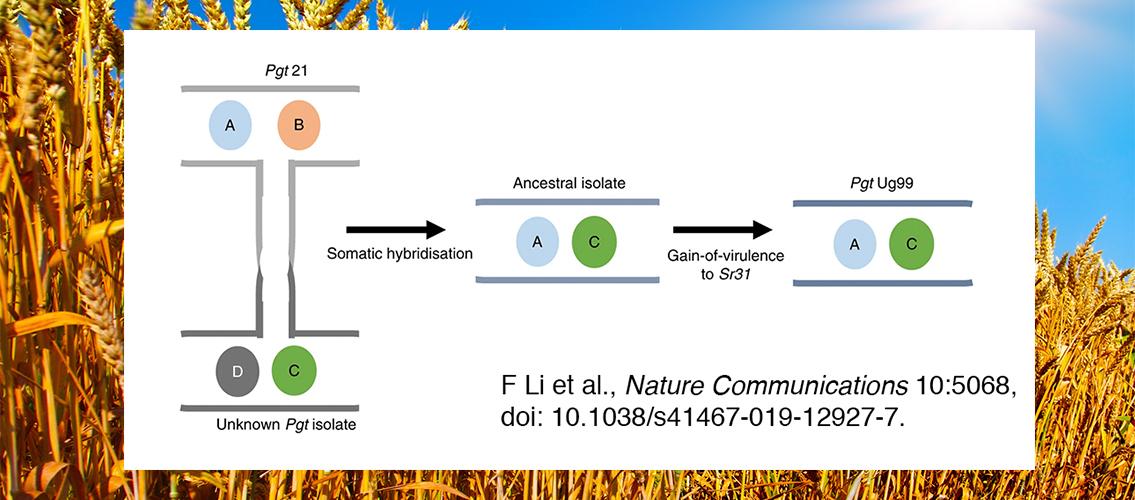
The Ug99 strain of the wheat stem rust fungus (Puccinia graminis f. sp. tritici or Pgt), appeared in Africa in the late 1990s and has become a major threat to wheat crops worldwide. Ug99 is extremely virulent and has caused several epidemics in Africa and the Middle East, with the possibility that it will continue to spread to other regions of the world. Scientists are trying to discover more about this fungus to develop new ways to combat it.
Researchers had previously known that the genome of Ug99 is distinct from other lineages, suggesting it did not arise from a mutation in some other established strain of Pgt. MSI PIs in the Department of Plant Pathology (College of Food, Agricultural, and Natural Resource Sciences) and their colleagues used genomics to investigate how the Ug99 lineage arose. They discovered that the origin of Ug99 came by a process called somatic hybridization. In this process, two dikaryotic (containing two nuclei) fungi strains fused and exchanged intact nuclei. One of Ug99’s two nuclei is identical to a much older strain of Pgt called Pgt21-0. This somatic hybridization event gave rise to Ug99, which has a wider virulence spectrum on wheat than its suspected parental strains, rendering it a major threat to food security worldwide.
The researchers recently published their discoveries in the journal Nature Communications. The paper can be found on the journal website: F Li, NM Upadhyaya, J Sperschneider, O Matny, H Nguyen-Phuc, R Mago, C Raley, ME Miller, KAT Silverstein, E Henningsen, CD Hirsch, B Visser, ZA Pretorius, BJ Steffenson, B Schwessinger, PN Dodds, M Figueroa. 2019. Emergence of the Ug99 Lineage of the Wheat Stem Rust Pathogen Through Somatic Hybridisation. Nature Communications 10:5068. doi: 10.1038/s41467-019-12927-7.
The MSI researchers include:
- Corresponding author and Associate Professor Melania Figueroa (now at the Commonwealth Scientific and Industrial Research Organisation in Canberra, Australia); co-authors Feng Li, Dr. Hoa Nguyen-Phuc (now at Vietnam National University) and Eva Henningsen were members of the Figueroa MSI group
- Professor Figueroa’s group used MSI for comparative genome analysis of rust fungi and cereals.
- Assistant Professor Cory Hirsch; co-author Eva Henningsen is a member of the Hirsch MSI group
- Professor Hirsch’s group uses MSI for genomic research into the biology of stress resistance in plants.
- Professor Brian Steffenson; co-author Oadi Matny is a member of the Steffenson MSI group
- Professor Steffenson’s group uses MSI as part of a project to clone rust resistance genes from wild relatives of cereal crops.
- Dr. Kevin Silverstein, Scientific Lead and Informatics Analyst, MSI Research Informatics Solutions group
Other members of the team are scientists from the Commonwealth Scientific and Industrial Research Organization (Australia), Australian National University, and the University of the Free State (South Africa).
An article about the research also appears as a Research Brief on the University of Minnesota’s News website: Research Brief: Origin of Deadly Wheat Pathogen Revealed.
Image description: Model for Ug99 origin by somatic hybridization and nuclear exchange. The ancestral isolate of the Ug99 lineage acquired the A and C genomes from an isolate of the 21 lineage and an unknown isolate and later gained virulence to wheat cultivars carrying the Sr31 resistance gene. Image and description F Li et al., Nature Communications, 10:5068, doi: 10.1038/s41467-019-12927-7.
Posted on December 13, 2019